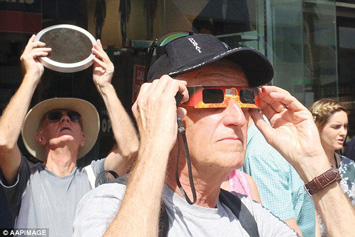Make Illinois state parks your home for the 2024 total solar eclipse
 Seven years after the 2017 total eclipse thrilled and delighted viewers in the Midwest, another total solar eclipse will be visible over 128 miles of Illinois the afternoon of April 8, 2024. The next total solar eclipse visible in the United States won’t be until 2044.
Seven years after the 2017 total eclipse thrilled and delighted viewers in the Midwest, another total solar eclipse will be visible over 128 miles of Illinois the afternoon of April 8, 2024. The next total solar eclipse visible in the United States won’t be until 2044.
Thirty-one Illinois state parks and sites managed by the Illinois Department of Natural Resources are in the eclipse’s path of totality. Numerous other parks and sites lie just outside the path of totality, offering equally spectacular views of the eclipse, though for shorter periods of time.
Southern Illinois is considered the eclipse crossroads of America because it was in the centerline for the path of totality in 2017 and will be again in 2024.
PATH OF TOTALITY
The largest Illinois city in the path of totality is Carbondale. In downtown Carbondale the eclipse will begin moments before 2 p.m. and last for four minutes and nine seconds, which is nearly double the length of time of the 2017 eclipse.
During the eclipse – with the cooperation of the spring weather in Illinois – the sky will darken, the air will cool, stars and planets will become visible, and a 360-degree sunset will be visible.
Make plans today to visit an Illinois state park to view the eclipse and experience this natural phenomenon.
2024 ECLIPSE FACTS
- The April 8, 2024, total solar eclipse will cross North America, including portions of the United States, Mexico and Canada.
- The next total solar eclipse to be visible in the lower 48 states will happen on Aug. 23, 2044.
- The eclipse will first enter North America in Mexico, then will reach Texas. From there it will travel through Oklahoma, Arkansas, Missouri, Illinois, Kentucky, Indiana, Ohio, Pennsylvania, New York, Vermont, New Hampshire and Maine before entering Canada.
- The last total solar eclipse to travel over Illinois was Aug. 21, 2017.
ECLIPSE SAFETY
Eye safety is extremely important when viewing a solar eclipse. Never look directly at the sun and be sure to acquire safe, certified solar viewers early. Viewing the sun with the naked eye or through regular sunglasses, a camera lens, binoculars, or telescope without appropriate solar filters can cause instant and severe injury to the eye.
To purchase eclipse glasses for your school or organization, please consider placing an order with Rainbow Symphony (https://www.rainbowsymphony.com/collections/eclipse-glasses-safe-solar-viewers) or consider bringing your students to the SIU campus to participate in the Eclipse Show in Saluki Stadium April 8. Call 877-725-8547 for tickets. Eclipse glasses will be provided to all attendees. For information, visit https://eclipse.siu.edu/festival.
For more information on viewing a solar eclipse safely, visit https://eclipse.aas.org/eye-safety.
(Information from the Illinois Department of Natural Resources.)
MORE ON HOW TO VIEW A SOLAR ECLIPSE SAFELY
- Always inspect your solar filter before use; if scratched, punctured, torn, or otherwise damaged, discard it. Read and follow any instructions printed on or packaged with the filter.
- Always supervise children using solar filters.
- If you normally wear eyeglasses, keep them on. Put your eclipse glasses on over them, or hold your handheld viewer in front of them.
- Stand still and cover your eyes with your eclipse glasses or solar viewer before looking up at the bright sun. After looking at the sun, turn away and remove your filter — do not remove it while looking at the sun.
- Do not look at the uneclipsed or partially eclipsed sun through an unfiltered camera, telescope, binoculars, or other optical device.
- Do not look at the sun through an unfiltered camera, telescope, binoculars, or any other optical device while using your eclipse glasses or handheld solar viewer in front of your eyes — the concentrated solar rays could damage the filter and enter your eyes, causing serious injury.
- Seek expert advice from an astronomer before using a solar filter with a camera, telescope, binoculars, or any other optical device; note that solar filters must be attached to the front of any telescope, binoculars, camera lens, or other optics.



Leave a Reply